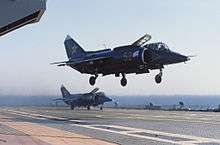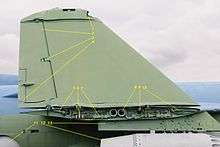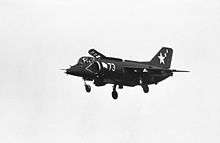Yakovlev Yak-38
| Yak-38 | |
|---|---|
 | |
| A Yak-38 on the deck of a Soviet aircraft carrier | |
| Role | VTOL Fighter aircraft |
| National origin | Soviet Union |
| Manufacturer | Yakovlev |
| First flight | 1971 |
| Introduction | 1976 |
| Status | Retired, 1991 |
| Primary user | Soviet Navy |
| Produced | 1971–1981 |
| Number built | 231, including Yak-38U — 34 Yak-38M — 52 |
| Unit cost |
US$18.5 million in 1996[1] |
| Developed from | Yakovlev Yak-36 |
The Yakovlev Yak-38 (Russian: Яковлев Як-38; NATO reporting name: "Forger") was the Soviet Naval Aviation's only operational VTOL strike fighter aircraft, in addition to being its first operational carrier-based fixed-wing aircraft. It was developed specifically for, and served almost exclusively, on the Kiev-class aircraft carriers.
Design and development
Designed by the A.S. Yakovlev Design Bureau JSC, the first drawings showed a supersonic aircraft strongly resembling the Hawker P.1154 in study in the United Kingdom, but with two R27-300 engines. Supersonic performances would have implied many difficulties of development, and it was decided to initially develop a relatively simple aircraft limited to Mach 0.95. Although the Yak-38 and Yak-38M were developed from the land-based Yakovlev Yak-36, the aircraft had almost nothing in common.
The prototype VM-01 was finished on 14 April 1970. Though outwardly similar to the British Hawker Siddeley Harrier, it followed a completely different configuration. Together with a vectorable thrust engine in the rear used during flight, two smaller, and less powerful, engines were housed in the front portion of the fuselage and used purely for takeoff and landing.[note 1]
The Yak-38 possessed an automatic ejection seat. If one of the takeoff engines failed, once the aircraft rolled past 60 degrees the pilot was automatically ejected from the aircraft.
Operational history


The majority of Yak-36M initial production deliveries were to the 279 OKShAP (Otdelny Korabelny Shturmovoy Aviatsionny Polk, Independent Shipboard Attack Air Regiment), initially based at Saki, the AV-MF's training centre in Crimea.
In July 1979, Minsk arrived in the Sea of Japan, where the vessel was home-ported at Strelok Bay, the Yak-38 component of its air wing thereafter being provided by the 311 OKShAP subordinate to the Pacific Fleet.
In September 1982, Novorossiysk – the third Kiev-class carrier – was commissioned. By now the V/STOL technique had been well practised, and the resulting increase in the Yak-38's overall performance and capability was exploited during the passage of Novorossiysk from Severomorsk to join the Pacific Fleet. In a maritime context, the Yak-38 was not limited to the decks of Kiev. In September 1983, AV-MF pilots operated from the civilian Ro-Ro vessel Agostinio Neto, and NII-VVS pilots conducted further tests from another 'Ro-Ro', Nikolai Cherkasov. In both cases, use was made of a heat-resistant landing platform; further land-based trials tested the practicality of dispersed landing platforms, in a similar concept to the RAF's Harrier operations in West Germany.[2]
Variants

- Yak-36M "Forger"
The initial pre-production version, differing slightly from the Yak-38. It weighed only 6,650 kg (14,660 lb) compared to the Yak-38's 7,370 kg (16,250 lb) and the engines were slightly less powerful.
- Yak-38 "Forger-A"
The Yak-38 was the first production model, it first flew on 15 January 1971, and entered service with the Soviet Naval Aviation on 11 August 1976. A total of 143 Yak-38s were produced.
- Yak-38M "Forger-A"
The Yak-38M was an upgraded version of the Yak-38, the main difference being the new Tumansky R-28V-300 and Rybinsk RD-38 engines. The maximum takeoff weight in VTOL was increased from 10,300 kg (22,700 lb) to 11,300 kg (24,900 lb) (12,000 kg (26,000 lb) in short takeoff mode). The air intakes were slightly widened and the underwing pylons reinforced to carry a 2,000 lb (910 kg) weapons load. The Yak-38M entered service with the Soviet Naval Aviation after June 1985, a total of 50 Yak-38M being produced.
- Yak-38U "Forger-B"
Two-seat training version of the Soviet Naval Aviation. This version differed from the basic aircraft in having an enlarged fuselage to accommodate a two-seat cockpit. The Yak-38U entered service on 15 November 1978, a total of 38 Yak-38U being produced, with the 38th aircraft being delivered in 1981.
Unbuilt projects
- Yak-39
Multi-role fighter/attack aircraft project dating from 1983, employing one R-28V-300 and two RD-48 engines, PRNK-39 avionics suite; S-41D multi-mode radar, larger wing, increased fuel capacity and expanded weapons options based around Shkval or Kaira PGM designation systems.[2]
Operators
Specifications (Yakovlev Yak-38M)

Data from Combat Aircraft since 1945[3]
General characteristics
- Crew: one
- Length: 16.37 m (50 ft 1 in)
- Wingspan: 7.32 m (24 ft 0 in)
- Height: 4.25 m (14 ft 5 in)
- Wing area: 18.5 m² (199 ft²)
- Empty weight: 7,385 kg (16,281 lb)
- Loaded weight: kg (lb)
- Max. takeoff weight: 11,300 kg (28,700 lb)
- Powerplant: 1 × Tumansky R-28 V-300 turbojet, 66.7 kN (15,000 lbf)
- Powerplant: 2 × Rybinsk RD-38 turbojets, 31.9 kN (7,870 lbf) each
Performance
- Maximum speed: 1 280 km/h (795 mph)
- Range: 1,300 km[4] (807 miles)
- Service ceiling: 11,000 m (36,089 ft)
- Rate of climb: 4,500 m/min (14,760 ft/min)
- Wing loading: kg/m² (lb/ft²)
- Thrust/weight: 1+
Armament
- Guns: GSh-23L 23mm gun pod (GP-9). Carried in one or two UPK-23-250 pods fixed under the external pylons of wings.
- Hardpoints: 4 with a capacity of 2,000 kg (4,400 lb) and provisions to carry combinations of:
- Rockets: various types of rockets (up to 240 mm).
- Missiles: 2 anti-ship or air-to-surface Kh-23 (AS-7 Kerry). The Kh-23 required a guidance pod on one of the pylons. R-60 or R-60M (AA-8 Aphid) air-to-air missiles could be carried under the external pylons.
- Bombs: two FAB-500 or four FAB-250 general purpose bombs under pylons, two incendiary ZB-500, or two nuclear RN-28 bombs.
- Other: external tanks.
See also
- Related development
- Aircraft of comparable role, configuration and era
References
Notes
- ↑ The Harrier has only one engine, the thrust being vectored through nozzles fore and aft.
Citations
- ↑ "Military aircraft prices." aeronautics.ru. Retrieved: 26 July 2011.
- 1 2 Newdick, Thomas. "The Soviet Navy 'Forger': Yak-36M, Yak-38, Yak-38U and Yak-38M." Air Combat Information Group, 27 November 2004. Retrieved: 16 July 2008.
- ↑ Wilson 2000, p. 145.
- ↑ "Vertical take-off/landing aircraft: Yak-38." Yakovlev Design Bureau, 16 July 2008.
Bibliography
- Wilson, Stewart. Combat Aircraft since 1945. Fyshwick, Australia: Aerospace Publications, 2000. ISBN 1-875671-50-1.
- "Yak-36 Forger—interim V/Stol." Flight International, 2 May 1981.
External links
| Wikimedia Commons has media related to Yakovlev Yak-38. |
- Yak-38 photo gallery
- Yak-38 Informationn
- Yak-36, Yak-38 and Yak-41 information
- Walkaround on 2 Yak-38 in Monino Aviation Museum, Russia